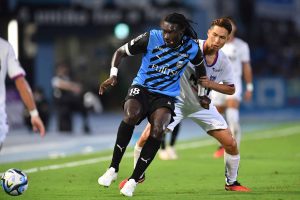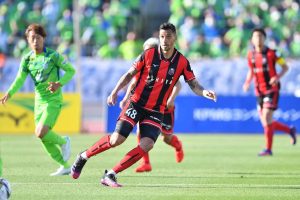
Andres iniesta shone in the J.League / photograph: Kenzaburo Matsuoka
Iniesta and the five top scorers of the World Cups – foreign players in 30 years history of the J.League
Andres Iniesta joined Vissel Kobe in May 2018.
With an estimated annual salary of 3.2 billion yen (22 million US dollar approximately), he became the most expensive player by far in the J.League history and shone in the midfield of the team in Hyogo prefecture – not regularly though – and fascinated Japanese football fans for almost five years. The scorer of the winning goal of the World Cup final in 2010 has made new history for Kobe by helping them win the Emperor’s Cup with his superb skills that belies his age, 39 year-old now.
While his salary and the quality of his performance were among the highest in the league’s history, there have been many world-class players who made an impact no less than Iniesta in the course of 30-year-old of the J.League. In particular, many big names came to Japan in the early days of the league. Even though the peak of their careers had passed, they showed their high level of experience and quickly raised the level of Japanese football which had only just become professional.
The biggest mentor was Zico of Kashima Antlers. He showed strong leadership and instilled a serious sense of professionalism in the team that had still been with amateurism in the beginning. Although he was already 40 years old, his performances were first class, scoring a hat-trick in the opening game of the J-League season for example.
Having played in the J.League for a year and a half, Zico continued to help strengthen Kashima after his retirement. It was because of him that Brazilian-born greats such as Leonardo (1994-96) and Jorginho (1995-98) joined Kashima.
The ‘Zico spirit’ has taken deep root in Kashima today, and it would be no exaggeration to say that the history of the club, boasting the most J.League titles of eight times, was created by Zico.
Former West Germany international and 1990 World Cup winner Pierre Littbarski came to play for JEF United Ichihara (currently JEF United Chiba) in 1993 for two seasons. Fellow countryman Guido Buchwald had played for Urawa Reds for four seasons from 1994, returned to Urawa as a manager in 2004, and led the club to its first league title in 2006.
Dragan Stojkovic of Nagoya Grampus was a long-running top figure in the J.League from 1994 to 2001, winning the MVP award in 1995 and, like Buchwald, returning to Nagoya as a manager after his retirement to lead the club to its first championship in 2010. In the 30-year history of the J.League, Stojkovic is the only player to win the MVP award as a player and the Best Manager award as a manager.
Former England international Gary Lineker was also at Nagoya (1993-94). Along with Zico, he was a standout player in the J.League at the start but failed to make a significant impact and ended up scoring four goals in 18 games over two years.
Who were the five World Cup scorers played in the J.League?
Dunga, the captain of Brazil which won the World Cup in 1994, was one of the best foreign players of all time in Japanese football. Having joined Jubilo Iwata in 1995, the defensive midfielder became the linchpin of the team to help win the league title in 1997 and was chosen for the MVP of the season. As a captain of Brazil, he managed to reach the final in two consecutive World Cups, but lost to France in 1998. At the same period, former Italy international Salvatore Schillaci also played for Iwata (1994-97).
Other prominent Europeans played in the J.League, including Kashiwa Reysol’s Hristo Stoichkov (1998-99) and Vissel Kobe’s Michael Laudrup (1996-97). In the 2000s, however, star players rarely came to Japan, partly due to clubs’ financial constraints.
Finally, a big name was back in the J.League in 2014 as Uruguay international Diego Forlan joined Cerezo Osaka. But Forlan failed to fit into the J.League environment and his first season ended with a lacklustre seven goals. His poor form was compounded when the team was relegated to the J2 League. Forlan was forced to play in the second division in the following season scoring 10 goals in 16 games but left the team in the middle of the season.
Then Vissel Kobe, backed by Rakuten, brought in Lukas Podolski in 2017, Iniesta in 2018, and David Villa in 2019. The three were named the ‘VIP Trio’, a combination of the first letters of their family names, and were a very special addition to the J.League. As Fernando Torres (2018-19) also joined Sagan Tosu, the J.League was once again revitalised by big-name players.
Incidentally, five World Cup scorers have played in the J.League such as Lineker, Schillaci, Stoichkov, Forlan, and Villa.
Recently, while promising young Japanese players are actively moving abroad, big-name foreign players are not joining again. Now Iniesta has left Japan, the lack of star players has become an important issue for the J.League, and new big names from abroad are eagerly awaited.

